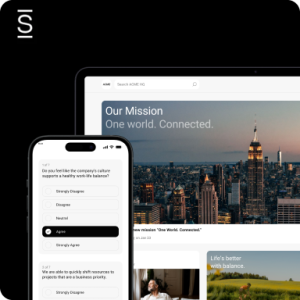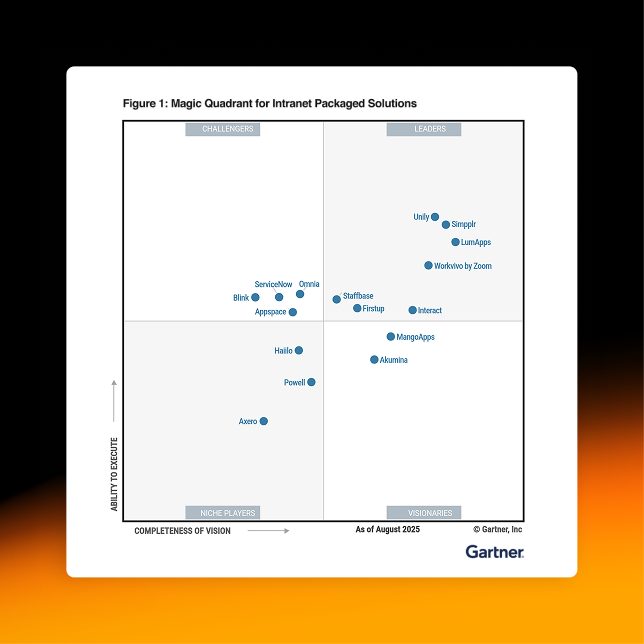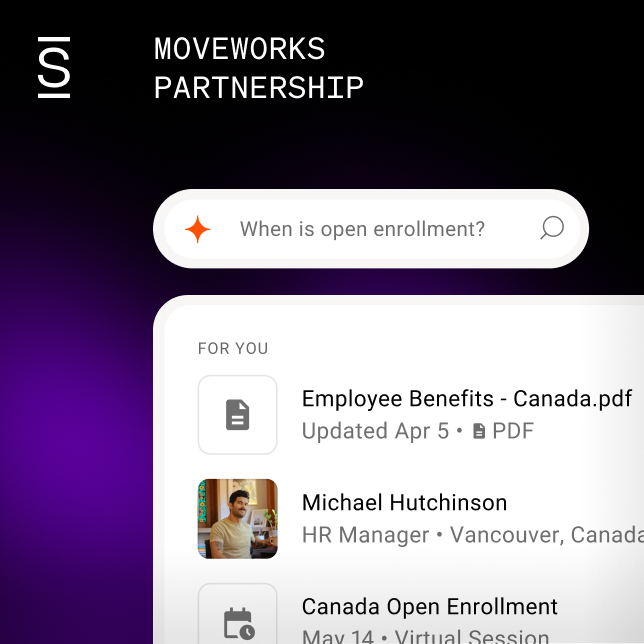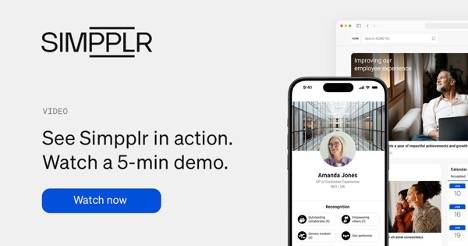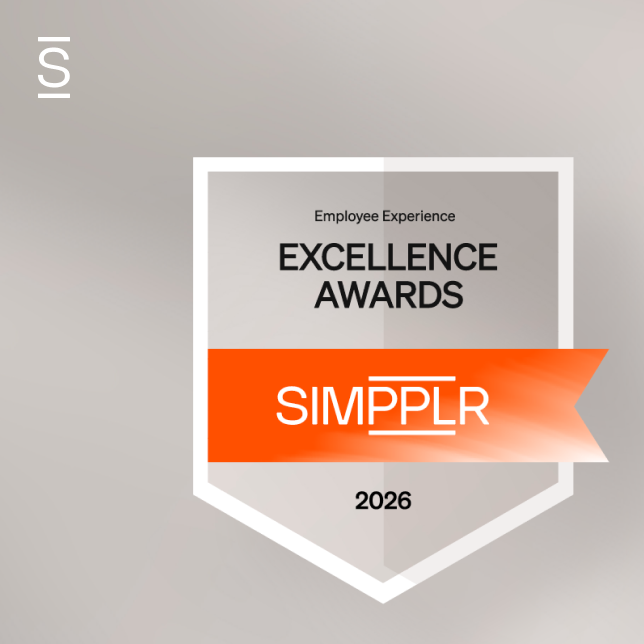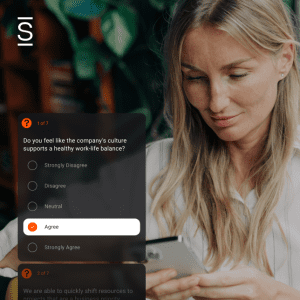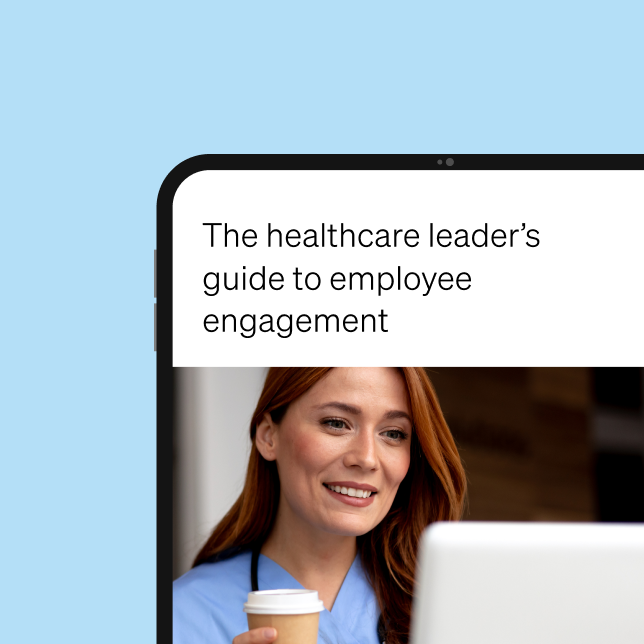Valued, trusted, supported, safe, and satisfied: This is the mental state of an engaged employee. But employees will not find these feelings themselves. Our list of employee engagement focus areas will help!
Have you ever seen The Office? Manager Michael Scott’s absurd ideas to boost employee engagement range from laughable to cringeworthy, but they all fail for the same reason: He has no idea how to relate to the people he works with.
It’s hilarious to watch, but there’s a lesson in it too. If you want to boost employee engagement, activities and gimmicks aren’t enough. You have to start with a foundation of trust, respect, and genuine human caring.
Employee engagement is on every organization’s mind, but how do you go about improving employee engagement? Buying more snacks won’t improve employee engagement. Neither will be adding one more happy hour event.
Organizations need to be careful to avoid falling into that trap of what they think employees want. Simpplr Research conducted a study to answer the question “what drives culture and engagement?” using data from Glassdoor and running regressions across a survey we deployed to the same audience. Based on the report, we found the top 3 drivers of improving employee engagement:
- Purpose: Showing employees how their work (and the work of the company has a positive impact). Employees need to feel that their work is meaningful and makes a difference.
- Alignment: Making sure that employees and executives are on the same page and that everyone understands how their work is impactful.
- Community: Creating an environment where employees feel safe, connected, and supported. The more an employee feels like a part of the community, the more engaged they are with what they do.
When forming employee engagement strategies, make sure they align with these top three key drivers.
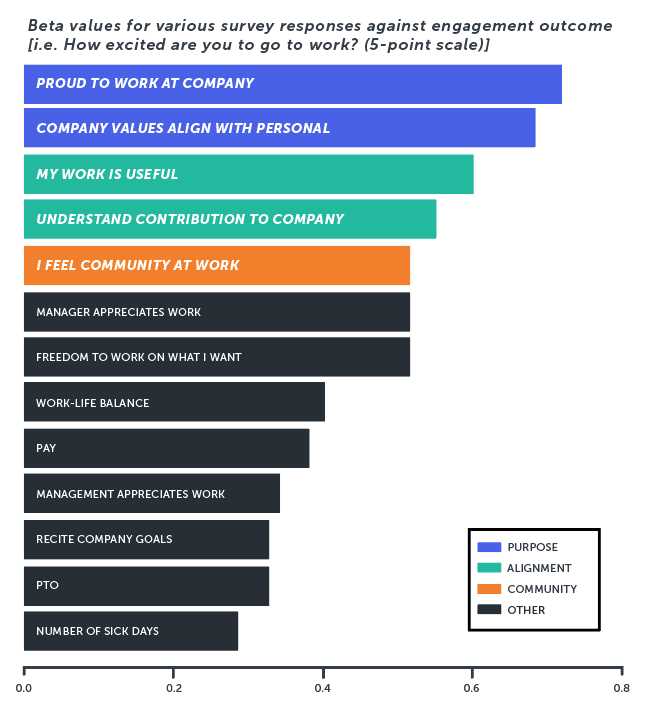
Before we get into it, let’s start with what it means to be engaged. Engaged employees aren’t just an HR buzzword. They’re people, dedicated to giving you their all.
They love their jobs. They’re collaborative and dependable. They’re constantly looking for ways to improve your business systems—for higher efficiency and better job satisfaction for everyone.
They might even shout about how happy they are on social media.
Managers often think that the difference between engaged and disengaged employees lies in the employees themselves, but that isn’t always true.
Happy, accomplished employees who feel stifled or unappreciated can fall into depression at work. And grumpy, defiant employees who feel recognized for their contributions can become enthusiastic, full of energy and have innovative ideas.
In other words, who you are as a leader profoundly affects who your team members are as employees.
So, start by building an avatar of your ideal engaged employee:
- How do they behave?
- How do they approach their job?
- What attitude do they bring to the team?
- How do they work with others?
Once you’re clear about what you want from your employees, ask yourself what someone would have to feel to behave that way. Chances are, your list will look something like this:
- Valued
- Trusted
- Supported
- safe
Give your employees good reasons to feel this way, and watch your workplace transform.
Research shows that US organizations lose more than $450 billion annually due to disengaged employees. If you want to remain competitive, implementing a good employee engagement program is a must—and 49 ways to do precisely that follow:
1. Purpose
Show employees that their position is essential to the broader company mission and that their contributions are crucial to its attainment.
Employees want to be sure that there is meaning in what they do, just as all people do. Beyond that, a purpose-driven workplace allows people to work on projects that are meaningful to them. And when the path to purposeful work is unclear, be sure to help them find it.
2. Mission
Share your company mission and how its pursuit helps improve the world.
Where the employee has a purpose, the organization has a mission. This is summed up in the mission statement. However, sharing your mission with the employees should go deeper than pasting the statement on every brochure and email signature. Make it part of your company culture..
3. Culture
Create a healthy culture that enhances the experience of existing employees and attracts the right candidates.
Some organizations are already in a culture quagmire that makes it impossible to implement employee engagement initiatives. Overhauling your company culture can start with a single team. Once you show that the new way of thinking leads to better results, it’s easy to spread it across the company.
When that team gets results, the culture that made it happen can spread throughout the organization.
The idea is simple: you want your employees to feel comfortable in their workspace. In addition, you want to create an environment that embodies your company values. For example, if you want to create a workspace that encourages collaboration and transparency, avoid having tall cubicles that block employees from engaging with one another.
Having an open floor space is conducive to open communication and fostering creativity. Make it inspiring so that employees are excited to come to work every day. Most spend eight hours a day in the office so it’s important to design a space that is welcoming, comfortable, and conducive to your company’s values.
So, no matter what specific decision you’re facing, show employees you care by asking yourself the same 4 questions every time:
- What can I do to make my employees feel valued?
- What can I do to show them I trust them?
- What can I do to make them feel supported?
- What can I do to show them they’re safe?
Transform your work environment into a safe space for everyone and encourage managers to become safe spaces for every employee.
Put these company values at the forefront by living and breathing them yourself every day.
4. Values
Share your company values to show and remind employees what you stand for and why..
Employees are more engaged with employers who share their values. Additionally, cultivating common values builds camaraderie among employees. You can also share values in practice by showcasing employees that embody those values in various scenarios—and this can apply at work and at home.
5. Benefits
Develop and share the organization’s goals with employees to act as a roadmap, motivation, and yardstick.
Working towards common goals improves employee morale and boosts their perceptions of the company. Keep employees focused on the goals by consistently communicating the company’s priorities. Go one step further and include employees during goal setting.
6. Goals and Metrics
Develop and share the organization’s goals with employees to act as a roadmap, motivation, and yardstick. Setting reasonable expectations should go without saying, but far too many employee work environments come with goals that feel unachievable. Or, even if they’re technically reachable, the numbers are barely eked out every month, making employees feel constantly stressed and under pressure.
Working towards common goals improves employee morale and boosts their perceptions of the company. Keep employees focused on the goals by consistently communicating the company’s priorities. Go one step further and include employees during goal setting.
For some managers, it feels counter-intuitive to bring those goals down. They worry that people won’t try so hard. But the truth is that reducing stress actually makes people better at their jobs.
Engaged employees want reasonable goals they can find new ways to beat, preferably by a lot. The right goals will give your team room to experiment with new, more efficient systems that might need several iterations before they’re perfected. Reasonable goals meet your business needs while giving your employees more time to work on strategic and tactical improvements.
Remember, engaged employees who feel valued and trusted don’t just want to succeed. They want to succeed wildly, going far beyond your expectations.
7. Rewards

Reward employees to foster and reinforce desirable attitudes, behaviors, and outcomes in the company.
Employees are happier when their efforts are acknowledged and appreciated. Create a formal rewards program that reflects your company’s values – brainstorm a bit about what it should incorporate. You can also engage employees by involving them in the identification of candidates for special rewards.
8. Incentives
Offer incentives for employee participation in various company initiatives and activities.
Offering incentives can energize employees to complete a task they would otherwise not be willing to perform. Be careful not to overly depend on incentives as the only way to secure engagement, though, as this expectation could backfire.
Ad hoc incentives tend to fail as an employee engagement strategy. Engaged employees don’t need gift cards to improve employee performance. They want to meet (and beat) their metrics because they care. Even bonus compensation packages can backfire in recession years, leaving you with disengaged employees unless your targets move with the market.
Engaged employees feel valued on a fundamental level. Offering great compensation can help them feel that way, but a poorly structured incentive program can do just the opposite.
An engaged workforce feels safe and valued through the natural ups and downs of your business cycles, knowing you’re doing everything you can to take care of them even through tough times.
9. Professional development
Provide opportunities for professional growth by developing an employee development program. Employees are more committed to companies that support their career advancement goals. Offer professional development opportunities through formal training, providing access to learning material and mentoring.
Remember that your employees crave personal growth. Employees want to be constantly growing and improving their skills. When employees stop growing and stop challenging themselves, they become bored and complacent in their roles. They eventually become uninspired and lack the motivation to creatively solve problems. When this happens, your organization misses out on opportunities that could really boost or improve the bottom line.
Your employees are the best source of new ideas and opportunities. Invest in your employee’s personal growth, help them build new skills, provide mentorship, and offer courses or industry conferences that will help them further develop their skills.
Engaged employees want to do more, learn more, and bring new skills to their teams. Help employees do that with professional development initiatives that can expand their skill sets to keep up with changing markets.
Engaged employees also help companies grow, providing new opportunities for promotions. And despite the old adage, great leaders are made, not born. Give your team access to leadership development programs to prepare them to move up.
10. Feedback
Encourage and provide actionable feedback throughout the organization, whether it’s top-down, bottom-up, or lateral.
Feedback improves employee engagement by drawing attention to particular areas, whether it’s positive or negative. Encouraging employees to give feedback makes them more attentive to their own behavior and the behavior of others, including colleagues and managers.
Employees want to know how they’re doing and where to improve. Monthly one-on-ones aren’t enough. Giving constructive feedback helps them grow and reassures them of their purpose. It’s important that continuous feedback is implemented from the top because it introduces a culture of feedback to your entire organization where employees are invited to provide direct feedback to their managers and the leadership team.
A continuous feedback loop should incorporate an action plan to follow up on feedback received from both employees and employers. Just as you can help employees grow into their roles, they can provide constructive feedback to help you grow in yours as well.
Today’s companies are using big data and AI to gauge everything from consumer habits to transportation routes. So, what does Harvard Business Review say you should still do the old-fashioned way?
Employee engagement surveys. Ask employees how they feel on a regular basis and listen to what they have to say.
But that doesn’t mean all employee engagement surveys are equal. In fact, Forbes reports that a majority of companies don’t take meaningful action based on the surveys they provide, which means they’re completely missing the point.
You shouldn’t ask about employee satisfaction just to measure employee engagement at work. You should ask because you want to improve it.
In other words, listening isn’t enough without action.
And that makes sense. People won’t feel valued if their feedback lands on deaf ears. When it comes to employee engagement surveys, action speaks louder than words.
11. Hiring
Optimize your hiring systems to reflect a work environment that prioritizes employee experience.
Employees are highly engaged as they transition into a new work environment. Moreover, their expectations, perspectives, and attitudes toward the organization can be shaped during the hiring process. Improve the onboarding process, improve HR, and train existing employees on how to best acclimate new colleagues.
12. Onboarding
You only get one chance to make a good first impression when a new employee walks in the door. Explain your company values and your intentions for your company culture, and ask your HR professionals to help employees maximize their benefits from the start.
Most of all, make sure your new hires know what to expect from their new job, and make sure they have everything they need to meet their objectives.
Job satisfaction starts on day one when employees feel confident that they’ll have the support they need to succeed. Your intranet can be extremely helpful to onboarding new hires.
If you want to change your corporate culture, don’t let new hires learn old lessons. Encourage new employees to innovate and collaborate, and be sure to recognize the rest of your team members as they also start taking steps in that direction.
When bringing in new managers, let them know you’re ready to shake things up. Be transparent about the challenges you face and the changes you want to see.
The right candidates will be eager to help, seeing those challenges as opportunities to show you what they can do.
13. Recognition
Find opportunities to recognize employees to make them feel seen and as part of the team. Employee recognition is one of the employee engagement ideas that promote a sense of belonging in the workplace. Things to recognize employees for can include exceptional performance, personal development, a career milestone, or an innovation.
However, it is important to think deeply about the behaviors you’re rewarding. While bottom-line metrics and profitability clearly matter, you can also reward the attitudes and behaviors you need to get you there. And those rewards aren’t always money.
Employee recognition shouldn’t always be about financial success. It should also be about living your company culture, bringing the right attitude to work, and thinking creatively.
Employee recognition is an important component of improving engagement within a workforce. Recognition doesn’t need to happen in a scaled program. Recognizing your employees can happen on a daily basis as a part of the company culture. This fosters an environment of appreciation and closeness within your organization.
The idea is to get your employees to feel valued and emotionally connected with their peers and leadership. These are two important components of feeling engaged in any organization.
To take a step further, create recognition and incentive programs that reward employees for their hard work and dedication. When creating a program, make sure that it embodies your company’s core values so that it has a purpose. Although we know that financial compensation isn’t the sole factor for employee engagement, it has the potential to motivate your workforce and unite performance.
Whether or not a new idea works, reward the initiative of bringing it to the table. That will keep new ideas coming.
14. Management
Create a leadership culture that understands and supports employee engagement. Employees will gauge their connection to the organization through their relationships with their immediate superiors. Managers have the strongest potential influence over the daily experiences of the employees. Ensure your managers are having meaningful conversations with their team members.
15. Office
Set up the work environment to support employee interaction, health, and performance.
Remember, as people gravitate towards hybrid work environments, the company will remain responsible for providing an inviting office whether the employee is working at home, on the go, or they are of the deskless variety.
16. Motivation
Understand what drives employees so you can apply it to inspire them and enhance performance outcomes.
Motivated employees are more committed to the work, are more satisfied with the job, and are more willing to learn and adopt new ways of doing things. They’re also more efficient in using company resources.
17. Work-life balance
Educate employees on the importance of prioritizing their work and personal lives, ensuring you’re not committing the offense of not prioritizing that balance yourself.
Encouraging people to disengage from work at the right time can boost employee engagement. Suppose people feel they need to work after hours or cut their vacation short to keep up, get your approval, or earn a reward. In that case, they might be engaged because of the pressure, but it’s not sustainable, and turnover will follow the inevitable burnout.
18. Quality time
Spend quality time with your employees to build connections and trust.
There are many love languages, and people prefer to receive love differently. This is very much like that: You can show employees that you value them through undivided attention or when working together on a project to demonstrate appreciation.
19. Fun and laughter
Have fun together, laugh, and encourage employees to socialize whenever appropriate. The right kind of laughter in the workplace can go a long way toward making people feel safe. Studies have shown that it reduces work stress and even improves our health.
Fun and laughter can reduce work-related stress and even improve health. Besides, having a sense of humor humanizes both the employer and employee, placing them at an equal level. Make sure the humor is appropriate and matches the circumstances.
The key is to make sure the humor is never at someone else’s expense. Managers who make fun of themselves, for example, actually earn more respect from their direct reports.
Part of the reason laughter works is chemical. It reduces the fight-or-flight response, making us feel more at ease. But it’s also a matter of association.
Laughter isn’t allowed in places that are seen as “serious.” Instead, we associate laughter with play. And play is a big part of creativity, experimentation, and thinking outside the box.
In short, laughter makes us feel safe to be creative, making us more likely to try new ways of doing things or suggest new ideas for improvement.
20. Collect data
Use various methods to collect essential employee data to understand them better and find new ideas for engagement.
Advanced employee experience technology gathers vast amounts of employee data and automatically analyzes it for you. You can also incorporate other methods, such as surveys and suggestion boxes, which can be done through the platform.
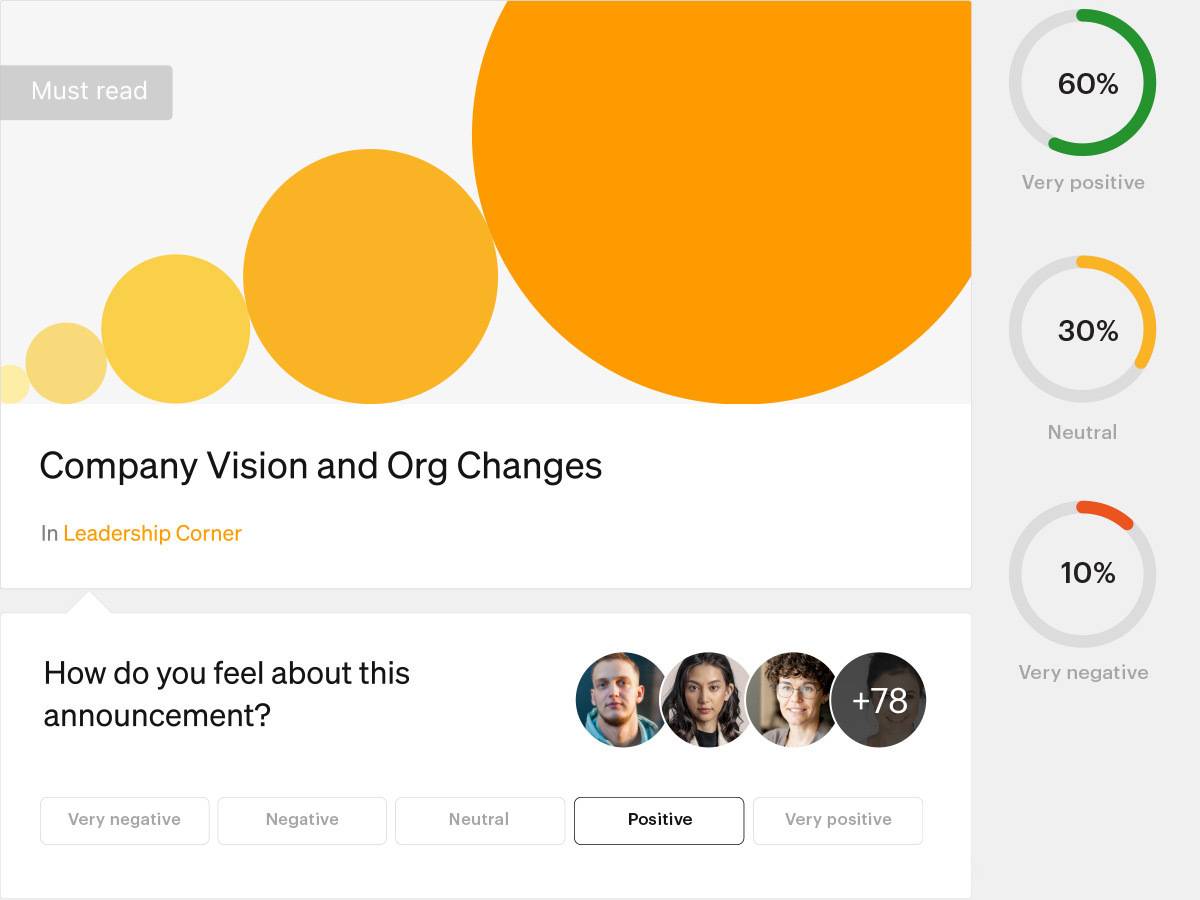
Unearth hidden employee sentiment in real-time with Simpplr’s Employee Surveys.
20. Team collaboration
Encourage people to collaborate not just within their departments and teams but across whatever silos for better results and engagement. Siloed teams have a hard time supporting each other. They don’t know what knowledge, skills, or needs other teams have.
Without knowing the needs of each other, siloed teams have a hard time supporting each other. Every team might be committed to the company’s mission and bottom line, but they still miss out on countless opportunities across their divisions. Break these barriers and bring groups together to improve employee engagement. While every team might be committed to the company’s mission and bottom line, they’re still missing out on countless opportunities across their divisions.
By bringing groups together on a regular basis, engaged employees can do even more for the company while feeling more engaged and connected than ever.
21. Respect
Develop respect among employees for themselves and their colleagues and leadership, ensuring it goes both ways. This may seem obvious, but you’d be surprised how many organizations overstep their boundaries. The foundation of every relationship is founded upon respect, and the most effective way to build trust in the workplace is by treating your employee just how you’d like to be treated.
Employees that feel respected are more confident about themselves and what they bring to the table. They think outside the box and freely share those thoughts –and you get more innovative ideas this way. And respect is crucial in organizations that promote familiarity between employees and their managers.
Respecting your employees means respecting their time, personal life, and how they want to be treated as an employee. When it comes to respecting your employees, be flexible and give them the autonomy to excel in their job and personal lives – and never micromanage!
22. Challenge
Keep employees on their toes by giving them new opportunities for growth that take them outside of their comfort zone.
Completing a challenge demands full attention and therefore boosts employee engagement. Constantly give teams or individuals new challenges that push away limiting beliefs, allow mistakes, and celebrate the lessons learned from failure. Rewarding new skill attainment is great too.
23. Ask
Ask what you don’t know and encourage honesty, whether it’s given directly or anonymously.

Ask employees directly about what you don’t know, whether it’s about their job position or their personal lives. Regarding personal information, remember to respect boundaries and understand people – some are natural sharers who will tell you much about where they come from. Still, others may be more reserved and prefer to keep their private lives private, especially in the beginning.
24. Community
We already know that community is a key driver in employee engagement. It’s important to promote a sense of community in the workplace so everyone feels comfortable and safe around others.
When employees have a sense of community, they are more likely to flourish at work, be more engaged, and remain with the company longer. Further, reduced stress at work allows employees to thrive outside as well, and this can reflect positively on your business.
Simpplr Research found that employees who do not feel a sense of community are 2x more likely to leave in the next 12 months than those who feel a strong sense of community. Creating a safe and friendly environment will encourage employees to come together and develop friendships. To spur new connections, organize off-site events, retreats, and bonding employee engagement activities that bring different teams and people together.
25. Accountability
Give employees rewards, responsibilities, and freedom but make it clear that they are also accountable for their actions.
Holding people accountable makes them more careful about their work. They are more likely to be efficient, make fewer errors, and perform better. However, make sure that the leaders are also shown to be held accountable.
26. Health
Prioritize employee well-being, investing in both their mental and physical health.
Poor health can lead to disengagement in various ways: Lack of physical strength to do the job, cognitive decline, thinking of the problems instead of working, etc. Investing in employee health up front helps the organization avoid these challenges down the line.
27. Corporate Social Responsibility (CSR)
Use your corporate social responsibility program as an opportunity to sensitize toward and encourage employee participation in social good.
Involving employees in CSR initiatives allows them to express interest in philanthropy, community service, environmental sustainability, and other things traditionally set aside for after-hours. Doing them at work enhances their connectedness with the company.
28. Internal marketing
Create a strong employer brand through an effective internal marketing strategy to keep employees proud of their employer.
Internal marketing increases employee engagement with the company’s mission and fosters brand advocacy. It’s a deliberate effort, not simply a result of communicating your company objectives and strategies. Communicators don’t typically have the skills to convince employees, so it should be left to Marketing and PR.
29. DEI
Support diversity, equity, and inclusion initiatives and activities within the organization.
People want to join and stay with organizations that are fair not just to themselves but to others. DEI initiatives nurture a sense of belonging in the employees. In fact, this feeling can be a strong predictor of the success of your DEI efforts.
30. DX
Implement your digital transformation strategy to improve productivity and interaction among employees.
Digital transformation is crucial for employee engagement both during the process where you involve them in the need assessment and after when the new systems improve the work environment.
31. Free time
Offer employees free time during their workday when they can pursue personal projects.
Some organizations say, “You’re free to work on your personal projects on your own time.” Google tells its employees, “Why don’t you take 20% of the time that I pay you for to work on your personal projects?” Check out the 20% Time program.

2:59
32. Celebrate
Foster a culture of noticing and celebrating when good things happen, whether small or not directly tied to work.
Celebrations allow employees to bond with each other and develop deeper connections with the workplace.
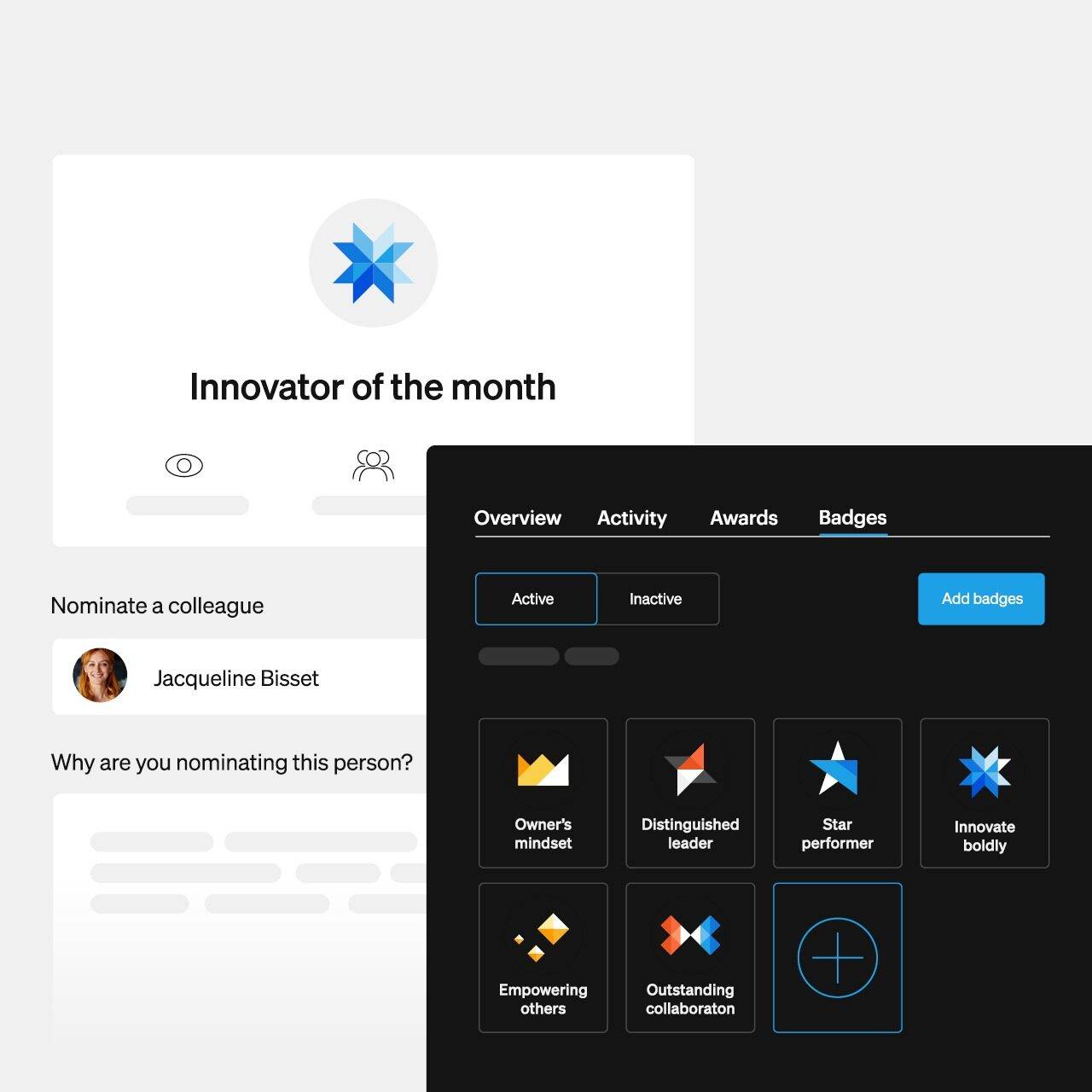
With Simpplr’s Rewards & Recognition you can empower your employees to recognize the achievements of their peers and can customize rewards based on company values, such as by rewarding for their contributions with gift cards, unique items, or cool company swag.
33. Assist
Provide your help whenever employees need it to perform their tasks or handle personal matters.
Employees are more comfortable working in an environment where they can get help from any direction. Employers should foster the culture by leading by example.
34. Enable
Don’t wait to be asked to provide the information, tools, and systems that employees need to perform.
Enabling employees means providing whatever they need for their job before they need it, from the right equipment to information and a conducive work environment.
35. Personalize
Whether it’s a message, a task, or equipment, make it relevant to the individual.
The cornerstone to sustainable employee engagement is appealing to people on a personal level.
36. Trust
Trust your employees and be transparent so they trust you too!
Employees should feel that you trust them to live by the organization’s values. And to earn their trust, you must be transparent. Things you may be tempted to keep from your employees include financial challenges, just as employees most frequently lie about having doctor’s appointments.
37. Know strengths
Assess your employees’ strengths and weaknesses, which can help you optimize their performance and offer guidance when needed.
Beyond what’s highlighted in the job description, make an effort to understand employee strengths and weaknesses better. You may discover things they don’t even know about themselves.
38. Fail
Make sure your employees are not afraid to fail by owning your own mistakes and showing what you’ve learned from them.
This one snuck up on you, didn’t it? But you have to embrace failure not just personally but publicly as well. Failure is another thing leaders are tempted to lie about, but it could bring employees closer.
39. Identify advocates
Identify employees who talk you up to their colleagues or customers to know what you’re doing right and encourage additional employee advocacy. It’s a cycle.
Employee advocacy means the employee is already engaged with the organization. You can use this as a stepping stone to inspire company-wide engagement.
40. Prune
Know when to let people go for the general good of the organization and prune tactfully.
Good employers are keen on attracting, retaining, and engaging talent, but they are also ready to let people go if they are not the right fit.
41. External help
Be open to bringing in external help to improve employee engagement.
External help includes motivational speakers, coaches, and other experts that you may not readily have in-house.
42. Social activism

Demonstrate that you care about what’s happening outside the organization by standing up for social causes.
The employees themselves care about these causes, or they may have relatives and friends who are directly affected by the issue.
43. Eat together
Improve relationships across the organization by encouraging employees and managers to have communal meals.
Sharing a meal is a well-known bonding activity. Join employees at lunch and encourage them to eat together on occasion.
44. Accommodate
Make accommodations for diverse employee needs, from simple requests such as bringing a pet to the office to more complex supports for people living with a disability.
Welcome employees to express themselves fully at work before you can decide what’s permitted and what’s not.
45. Promote
Encourage ambition and initiative by moving employees up in salary, responsibilities, rank, or all three combined.
When there are open positions, look within before hiring from outside. It shows employees are valued – and valuable!
46. Communicate
Encourage regular communication between employees and leaders, especially those who rarely come across each other.
Create effective communication channels that allow people to remain close, despite the physical distance between most employees.
47. Commit
Develop employee engagement strategies and commit to their full implementation.
For instance, if you decide to involve employees in CSR, don’t just do it once. Don’t just hold an office party the one time you’re stoked. Making it a regular thing will improve employee engagement.
48. Test
Test different methods and theories, then compare the outcomes to discover new superior approaches to employee engagement.
Testing will help you find unique ways to improve employee engagement most suited to your work environment.
49. Measure
To improve employee engagement, measure the effectiveness of your efforts by asking and through data analytics.
You can’t improve what you don’t know.
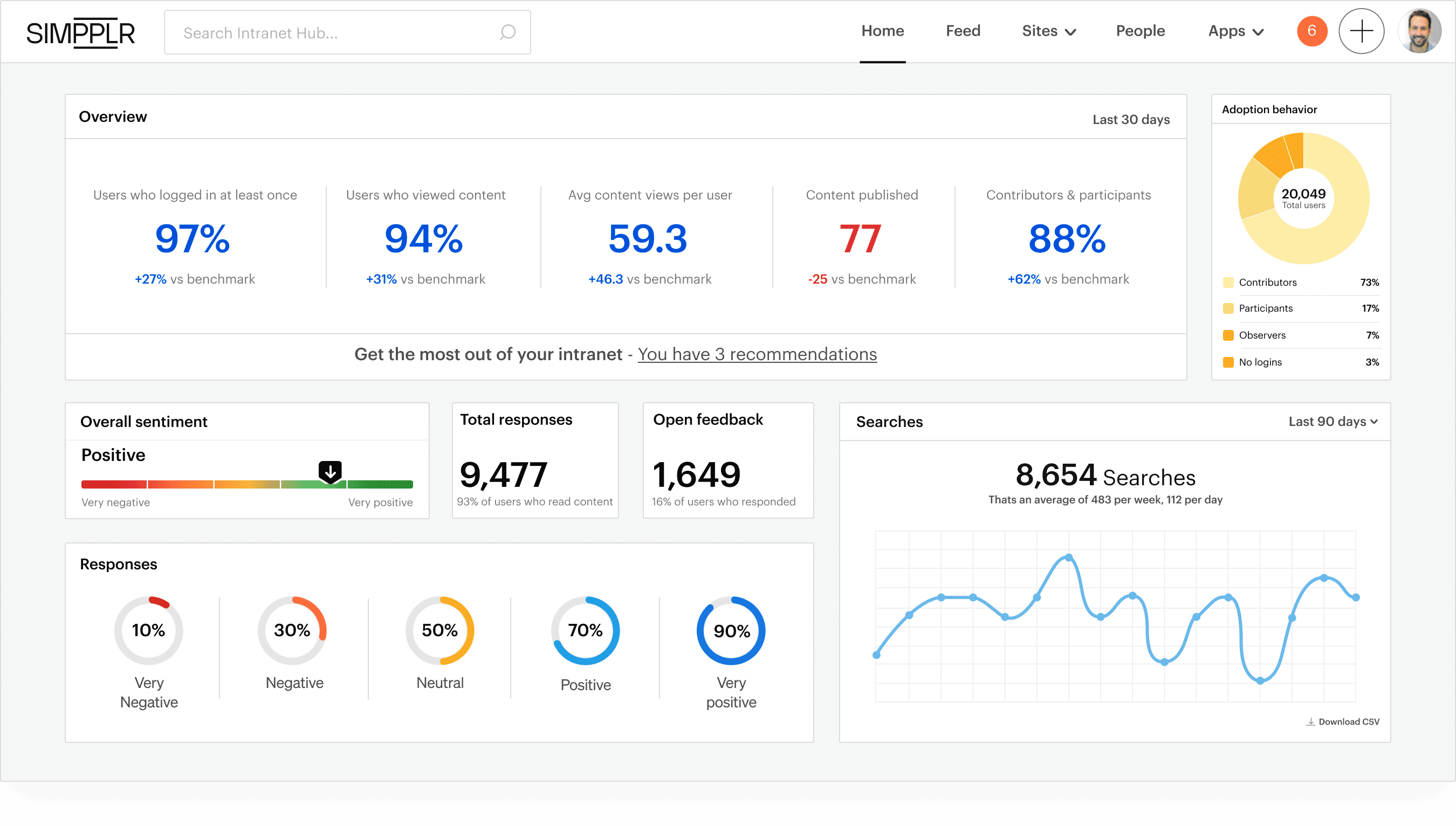 Go deeper than just views or visits to uncover real-time, actionable intelligence with Simpplr’s analytics and insights. Gain insights into employee sentiment, feedback, and behavioral signals to enable action.
Go deeper than just views or visits to uncover real-time, actionable intelligence with Simpplr’s analytics and insights. Gain insights into employee sentiment, feedback, and behavioral signals to enable action.
50. Improve
Use the insights you gather from measurement and testing to improve your employee engagement program.
Make measurement worthwhile by applying what you learn to make your employees more aligned, motivated, and engaged.
51. Inclusive Engagement
When it comes to fostering a positive and engaging environment in the workplace, taking an inclusive approach is paramount. Inclusive engagement means considering the unique situations, needs, and perspectives of all employees, whether in-person, remote, parents, non-parents, or individuals historically marginalized.
So, think intentionally about all your employees, and ask yourself the following questions:
- Do you have a mix of in-person and remote workers?
- What about parents and non-parents?
- Or employees whose voices have been historically marginalized?
Even remembering that some people are extroverts, and some are introverts will help you navigate your choices in designing employee engagement activities.
Trust exercises and team-building activities often force people out of their comfort zones to help them build relationships. If that isn’t handled extremely well, it has the potential to backfire.
It can also leave remote employees or parents who can’t attend feeling left out.
No matter how simple the activities you’re planning, from happy hours or group outings to in-office birthdays, think about the consequences. Are you giving a limited group of people more access to upper management? Will employees feel forced to “play politics” to succeed?
When everyone has an equal platform for their ideas and equal opportunities to earn promotions, group fun can be simply that—group fun!
Human beings aren’t perfect. Even in a workplace full of engaged employees, Human Resources will still have its hands full dealing with personnel issues.
The difference between an engaged workplace and a disengaged one isn’t about perfection. If anything, it’s the opposite. Engaged employees give them all because they know they have the space they need to make mistakes, learn, and grow.
Engage via an employee experience platform
These employee engagement ideas are best implemented on a robust employee experience and intranet platform. Take advantage of the latest technologies to reinforce your company culture and engage employees through AI-driven internal communications.
With a smart employee experience platform, you can protect your efforts to increase workplace collaboration, offer professional development, gather employee feedback, and transform your workplace in all kinds of ways.
Simpplr is the leading AI-powered employee experience platform that promises to deliver these outcomes. Connect for a live demo today, or watch a 10-min video.


